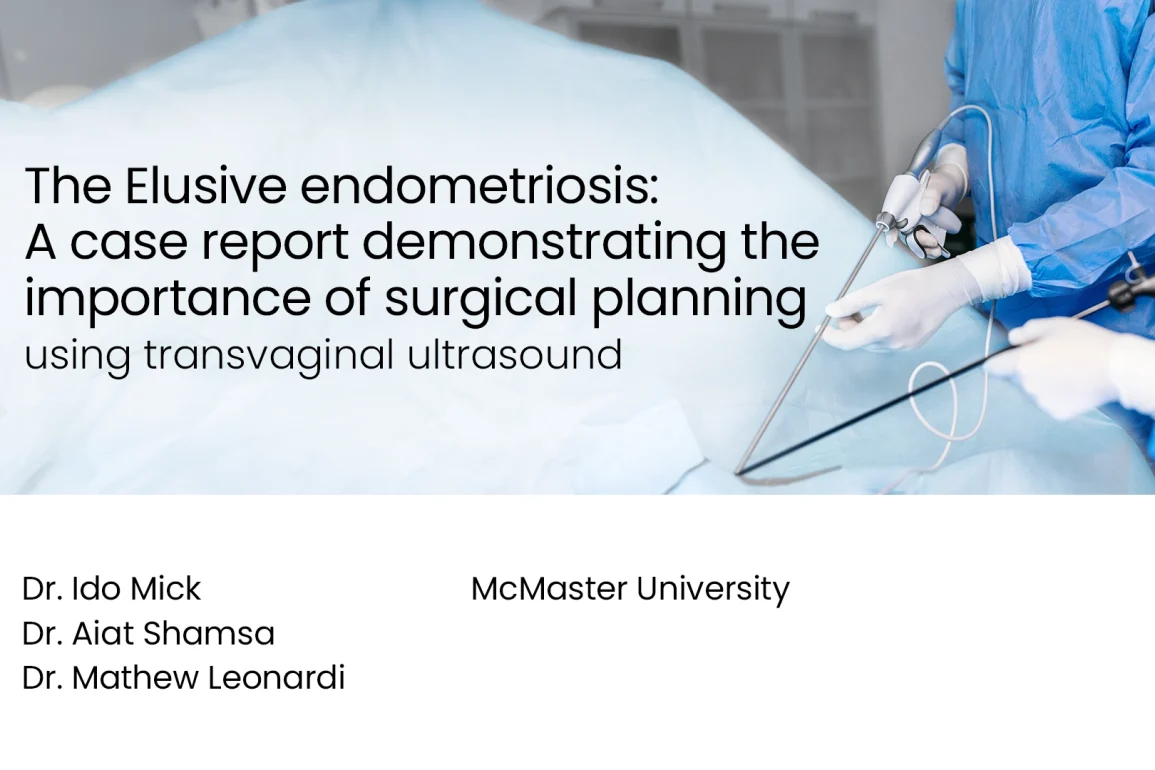Table of Contents
- Procedure Summary
- Authors
- Youtube Video
- What is the importance of surgical planning using transvaginal ultrasound?
- What are the Risks of surgical planning using transvaginal ultrasound?
- Video Transcript
Video Description
This video will discuss the clinical presentation of androgen insensitivity syndrome highlighting the different options of gonadal management in these cases which include gonadectomy followed by hormone replacement therapy, surveillance and gonadal transposition which facilitate monitoring. It will also demonstrate the principles of laparoscopic bilateral orchidectomy in these cases with a video demonstrating the steps.
Presented By

Dr. Aiat Shamsa



Affiliations
McMaster University
Watch on YouTube
Click here to watch this video on YouTube.
What is the importance of surgical planning using transvaginal ultrasound?
The Elusive Endometriosis: A Case Report Demonstrating the Importance of Surgical Planning Using Transvaginal Ultrasound presents a clinical case emphasizing the challenges of diagnosing and managing hidden or atypical endometriosis. This case report highlights the role of advanced imaging techniques, particularly transvaginal ultrasound, in identifying endometriotic lesions that may be missed through standard diagnostic methods.
- Definition of Elusive Endometriosis: Endometriosis that is difficult to detect or diagnose due to atypical lesion locations or minimal symptoms, which can complicate treatment planning.
- Role of Transvaginal Ultrasound: Transvaginal ultrasound allows for more precise visualization of pelvic anatomy, enabling the identification of subtle or hidden lesions, essential for effective preoperative planning.
- Impact on Surgical Outcomes: Detailed imaging informs surgeons of exact lesion locations and depths, reducing the risk of incomplete excision, recurrence, and complications.
- Case Insights: The report shares insights into managing such cases, underscoring that high-quality imaging is a cornerstone of tailored, successful surgical intervention.
In sum, this report underscores the value of thorough imaging in the management of endometriosis, advocating for transvaginal ultrasound as a critical tool in optimizing surgical outcomes and minimizing complications.
What are the Risks of surgical planning using transvaginal ultrasound?
Video Transcript: Importance of surgical planning using transvaginal ultrasound
The Elusive Endometriosis. Here we discuss a case to show the importance of surgical planning using transvaginal ultrasound and complete excision of endometriosis. This is a 37-year-old nulliparous female, referred with chronic pelvic pain and a previous surgical diagnosis of endometriosis. She has an unremarkable past medical history and a BMI of 29. A previous history of laparoscopic ablation of left uterosacral ligament endometriosis and left oophorectomy.
She underwent a community ultrasound that was reported as normal, had an anteverted normal-sized uterus. On the MacMaster endometriosis ultrasound scan, she was found to have an obliterated pouch of Douglas and a negative sliding sign, and a nodule was seen in the left uterosacral ligament. This was noted to be extending to the posterior vaginal wall. Also, a right uterosacral ligament nodule was noted.
Same as is demonstrated in this cine loop of the ultrasound, and this is the left side. So, noting the right and the left side uterosacral ligament nodules, the left side extending to the vagina, as well as the horseshoe lesion through the torus, extending from one uterosacral ligament to the other. Here, we’re showing the pulling sleeve sign and the bowel tethered and adherent in the area of the disease pulled onto the nodule.
Then we move on to evaluation of the superficial endometriosis, and we can see in the right pelvic side wall, a peritoneal pocket filled with fluid, and with hyperechoic foci of superficial endometriosis within the area. Assessing the anterior compartment, we can see superficial endometriosis nodules, so you can see small hyperechoic foci in the anterior compartment noted here.
Moving on to Surgical Findings, correlating them with the ultrasound findings that we’ve just discussed. This is left pelvic side wall. We can see that the anterior compartment, left sided superficial endometriosis that we discussed can be seen and confirmed surgically. This is the posterior cul-de-sac obliterated with a nodule and tethering of the bowel on the right side pelvic with the peritoneal fluid filled pocket and superficial endometriosis within.
Again, moving on to the right uterosacral ligament, and we can see the noted nodule surgically, and left sided nodule extending to parametrium, which, as you can note here, was not visible surgically. So, the extension of this nodule into the parametrium and into the vagina was noted with an ultrasound, however, and not visible at surgery.
Here we move on to the procedure. We’ve performed a left skeletonising of the internal iliac and ureterolysis. The left side pelvic side wall is being dissected. So is the left uterosacral ligament currently being dissected off, to access the parametrium. And the left-sided vaginal nodule that we previously discussed, extending from the left uterosacral ligament, onto the parametrium, into the vagina. This is then the left uterosacral ligament dissected and taken off.
Moving on to the right side. This is the right pelvic side wall, where the peritoneal fluid filled pocket exists with superficial endometriosis within, so we’re undermining and opening that space to excise that area. It’s been excised. Moving on to the right uterosacral ligament nodule that has now been excised. Now we’re entering the rectovaginal septum. Following this, we will open the pararectal spaces to dissect the disease and separate the tethered rectum from the nodule in the posterior compartment.
That’s the parametrium and the vaginal nodule excised from the left side, completing the excision of the disease, moving on to a hysterectomy to complete the surgery. But we believe that excision of the left uterosacral ligament nodule and left parametrium extending to the vagina. And the right pelvic side wall endometriosis within the peritoneal pocket would have likely been incomplete if a detailed ultrasound mapping of the disease was not performed preoperatively.
Thank you for your attention.


